
Risks and Opportunities of Climate Change
Chia Hsin Cement Group identifies climate-related risks and opportunities, evaluates potential impacts, and manages the indicators and targets of climate-related topics. Since 2021, the Group plans to use the TCFD (Task Force on Climate-related Financial Disclosures) as a framework to conduct climate risk matrix analysis on physical risks, transition risks, and other risk profiles based on the four core elements below.
Climate Governance
Management Structure for Climate Change Issues
The highest organization for climate change management of Chia Hsin Cement Group is the Sustainable Development Committee, which is headed by Mr. Jason K.L. Chang, Chairman of the Board of Directors, and Ms. Li-Hsin Wang, President and Chief Sustainability Officer of the Company. The Sustainability Office was established under the Committee, with the Manager of the Sustainability Office as the Executive Secretary, to report to the Committee and the Board of Directors on the progress of the greenhouse gas inventory (quarterly), the climate change strategy and objectives of the Chia Hsin Cement Group, and to oversee the progress of the implementation of the Climate Taskforce.
Starting in 2023, preparations began for the SBTi for carbon reduction. By the end of November 2023, we submitted a declaration to set our short-term organizational greenhouse gas (GHG) reduction target (Scope 1+2) to an absolute reduction of 42% by 2030, setting 2022 as the baseline year. Additionally, we will begin measuring and reducing other indirect GHG emissions (Scope 3).
The Company’s Sustainable Development Office is responsible for promoting sustainable developmentrelated planning and issues, and the Chief Sustainability Officer coordinates the management of the Office, which is composed of the several taskforces including Governance, Social Responsibility, Environmental Management, Climate and Risk Management with participation from the operating units of the Group and staff from various departments. The Office holds regular meetings for implementing and monitoring the Group’s sustainability goals and progress, and in 2023, the Office held 6 meetings.
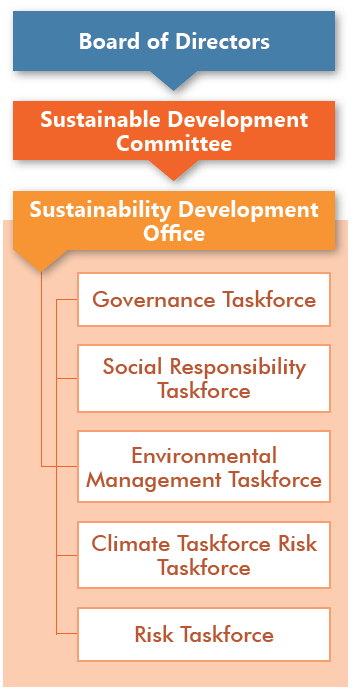
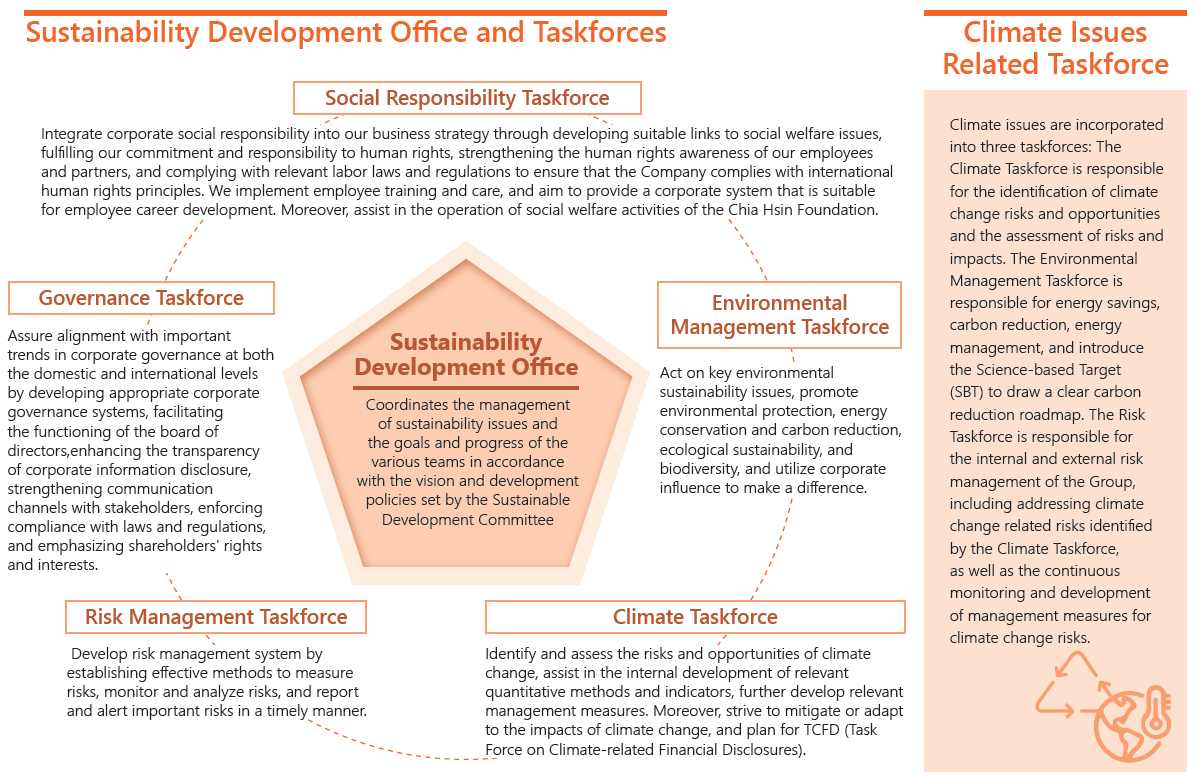
Climate Risk Management Structure and Mechanism
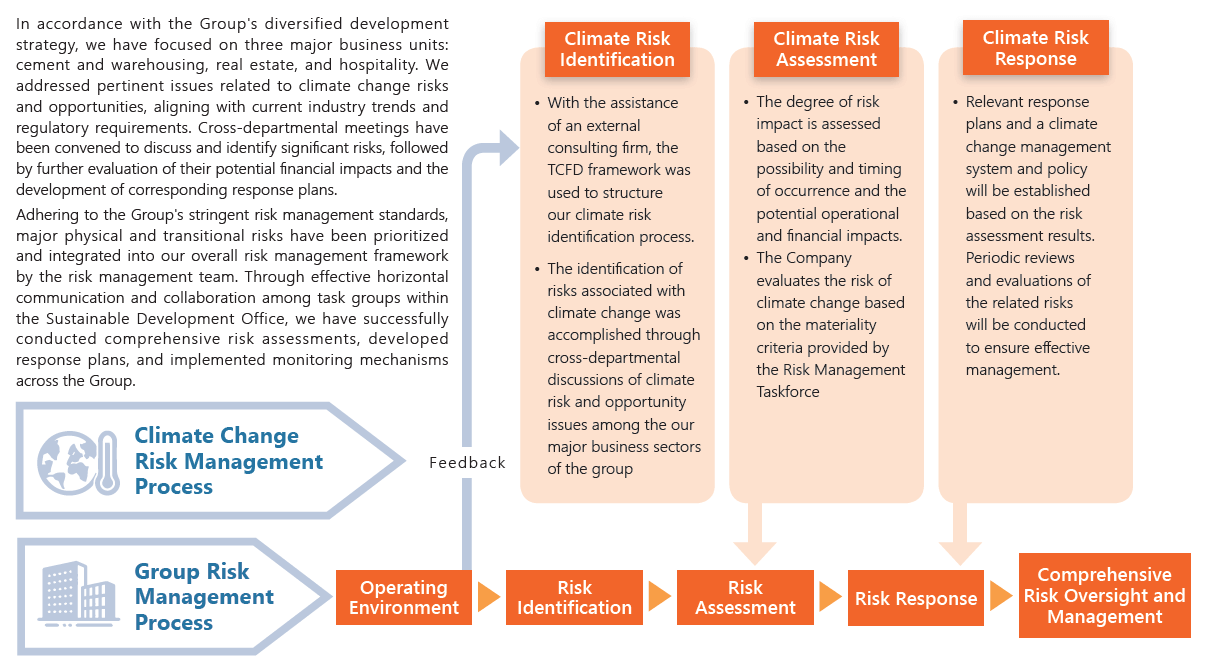
Strategy-Opportunity and Risk Identification Results
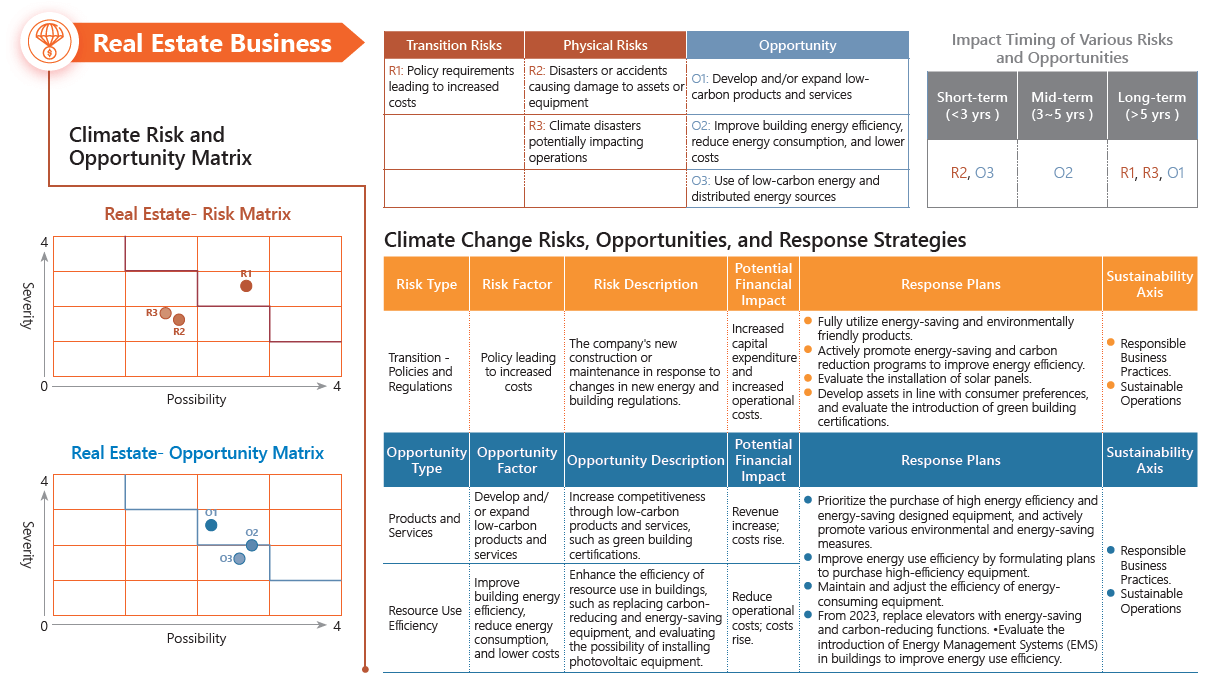
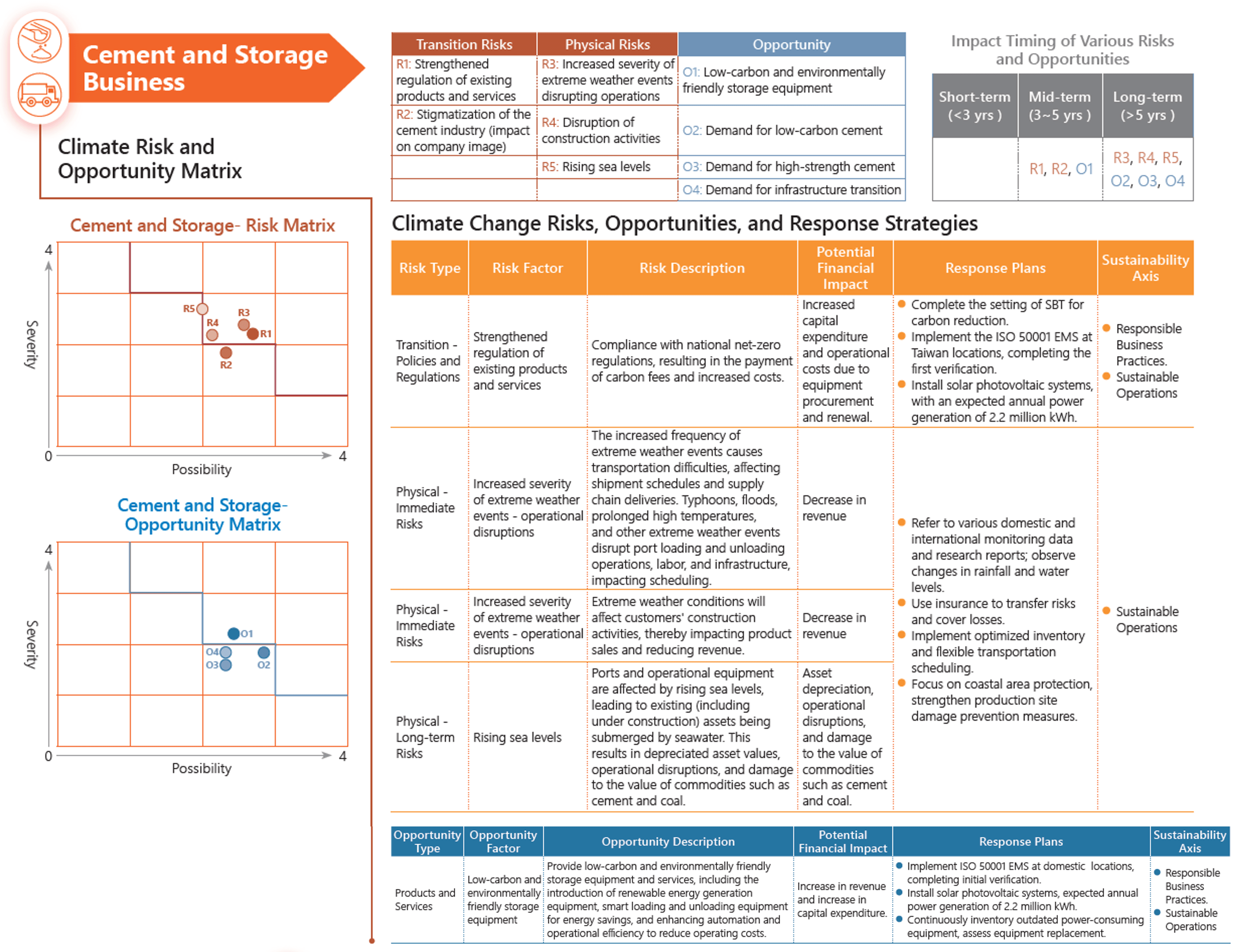
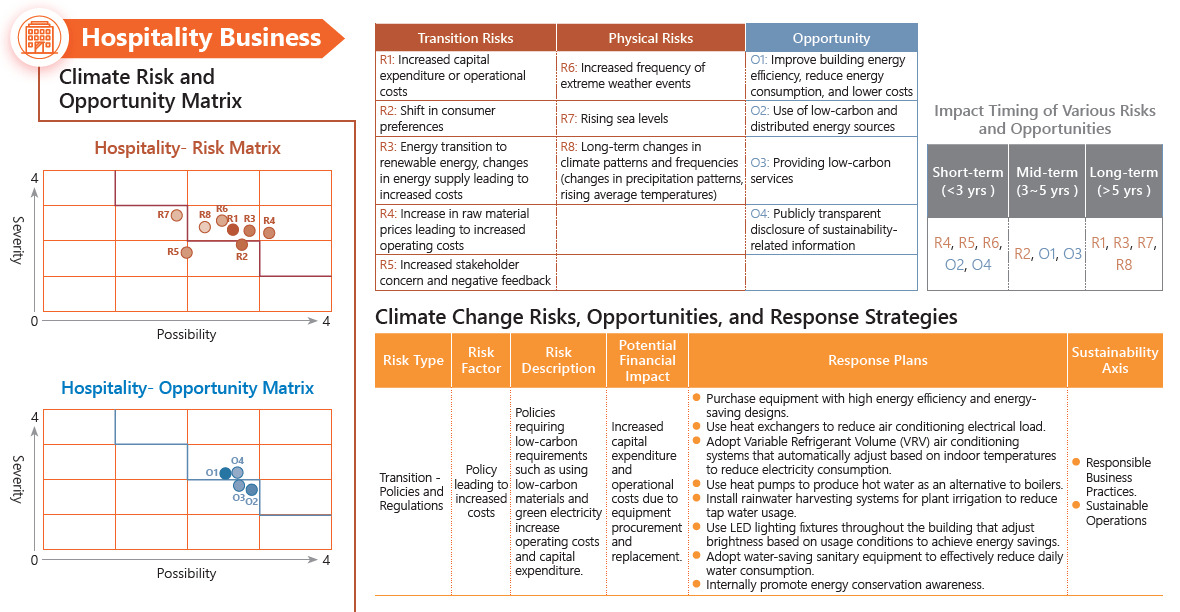
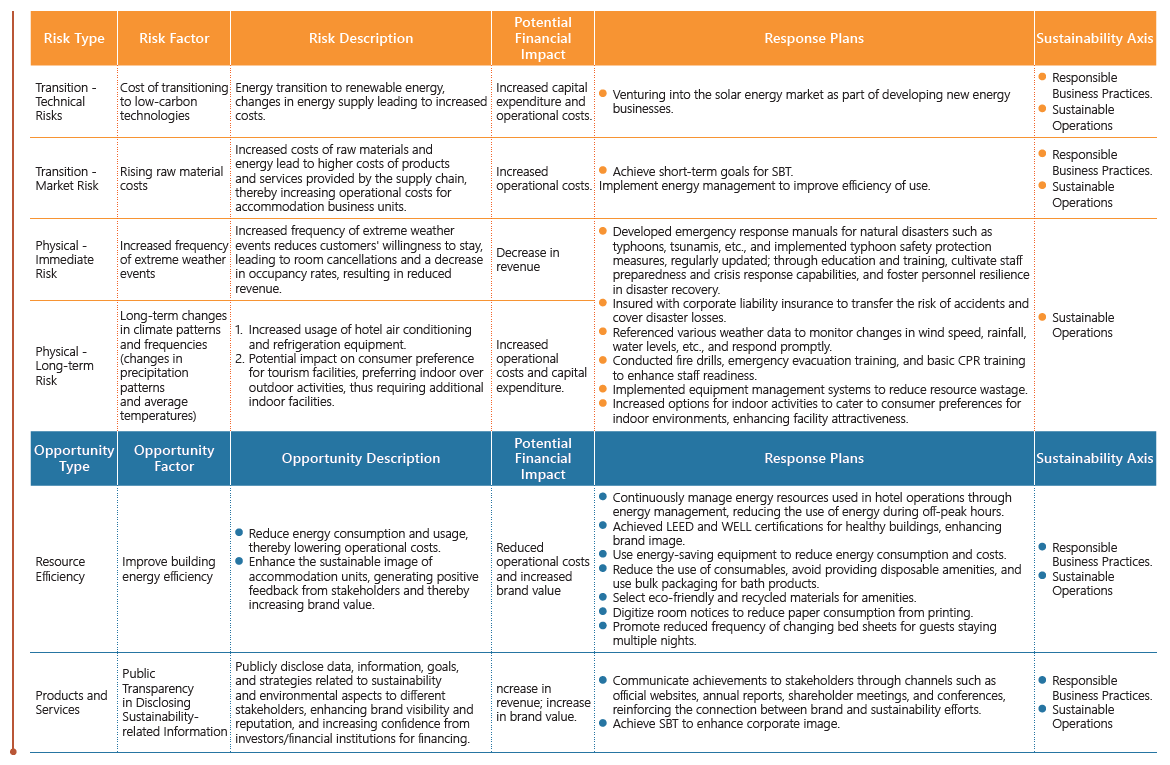
Climate-Related Scenario Analysis
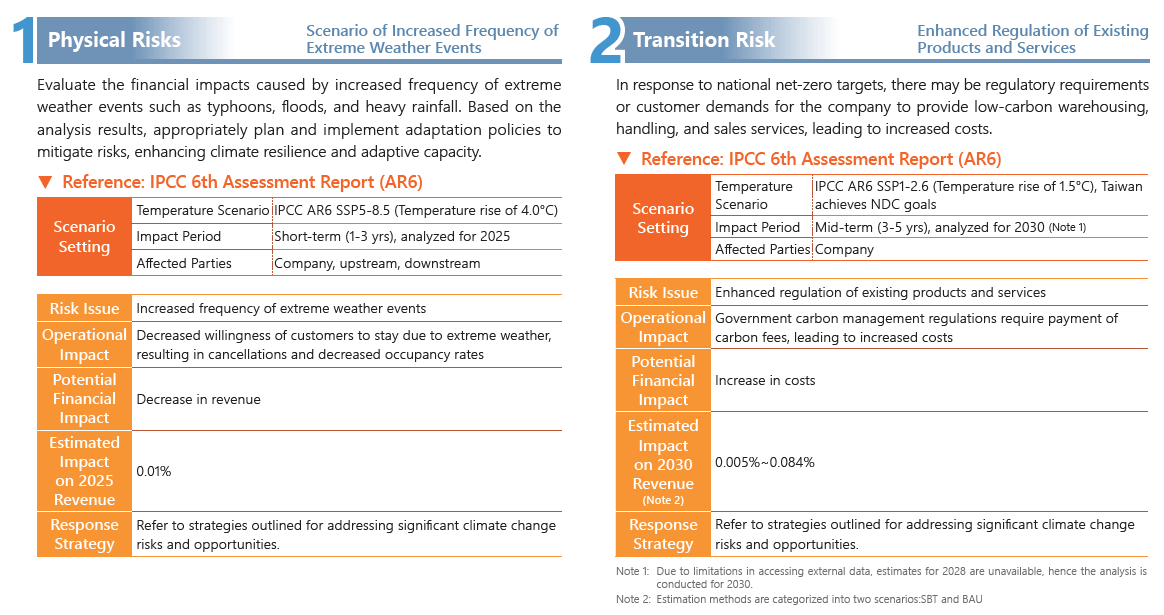
Diversified Business Activities
In response to climate change, the diverse development of the high-carbon cement industry can disperse the impacts of climate change and strengthen climate change resilience.
• Increased market needs and revenue
• Improved competitiveness due to market transformation
• Enhanced operational resilience
Management guidelines
1. Business diversification disperses climate- related operational and investment risks, and is included in the Group's investment evaluation and risks management systems.
2. Conduct overall evaluations to reduce investments in industries with high GHG emissions and increase the Group's proportion of low-carbon, high-resilience products and services.
Entering New Markets
Climate change promotes discourse on low-carbon emission and environmental impacts, indirectly drives the demand for new hotels and care center services in relation to healthy buildings.
• Increased market needs and revenue
• Improved competitiveness due to market transformation
• Enhanced operational resilience
Management guidelines
1. Conduct overall evaluations to reduce investments in industries with high GHG emissions and increase the Group's proportion of low-carbon products or services.
2. Introduce ISO 14064 and ISO 50001 management systems into all of the Group's operations to promote energy and GHG emissions related goals for our products and services and secure a competitive foothold in emerging sustainable markets.
Change in Customer Preferences
The adoption of LEED and WELL building standards, IHG Green Engage systems, and products or services with low energy intensity in response to climate change improves competitiveness and corporate image, which in turn enables us to obtain building bulk-ratio or floor-area-ratio incentives from the government.
• Increased market needs and revenue
• Improved competitive edge
• Reduced operational costs
Management guidelines
1. The Group's ESG and environmental sustainability strategies are established by governance and top-level management while dedicated teams are responsible for promoting the sustainable transformation plans.
2. Promote ESG goals related to our products and services to enhance brand value and customer awareness.
3. Green buildings in Taiwan are entitled to building bulk- ratio or floor-area-ratio incentives depending on the certification category. Such bonuses help to reduce the cost of managing and running the building.
Industry and Regulatory Changes, Reduced Customer Demand
Given the country's net zero emissions target, relevant laws, regulations, and state-mandated restrictions on the use of coal,as well as carbon reduction trends, it is necessary for the company to provide low-carbon products and services, which reduces the company's business activities while raising operating costs and capital expenditures.
• Reduced demand of services
• Increased operational costs
Management guidelines
1. Assess the regulation and control trends of each business for incorporation into the Group's risks management system, for the timely monitoring and adjustment of the management system.
2. Introduce ISO 14064 and ISO 50001 management systems into all of the Group's operations and set energy and GHG-related policies and goals to reduce the energy and GHG intensity of our services.
3. Promote business diversity to disperse climate- related investment risks.
Low-carbon Products Replacing Current Products and Services
Competitors provide better low- carbon warehousing, sales services and accommodation services.
• Reduced demand of services
• Increased operational costs
Management guidelines
1. Introduce energy and GHG management systems, set GHG-related policies and targets at the initial development and design stage of new businesses, enabling them to become top choices in the low- carbon market of the future.
2. Realize energy management, save energy, and reduce carbon emissions in regular operations, so as to reduce the dependency on the use of energy.
Rising Sea Levels
In regards to storage and hotel-related assets located in coastal areas, the rise in sea level may affect their long-term operation and asset values.
• Asset impairment
• Increased operational costs
Management guidelines
1. Assess the physical climate risks of the assets in both our current and planned operations; formulate backup plans such as an emergency reporting procedure or alternative working locations during emergencies; and evaluate the needs for relocation and redesign.
2. Incorporate physical climate risks into the Group's risks management system for regular review and monitoring. For suppliers located in low terrains, identify the risks of breach of contract or material supply disruption and plan for backup suppliers and materials in advance.
3. Periodically evaluate insurance coverage for assets that are exposed to physical climate risks.
4. Consider foundation elevation and appropriateness of location in new construction plans.
Increase in the Severity of Extreme Weather
Extreme weather fluctuations affect business operations, products, services, and asset status, as well as increase the frequency of asset maintenance.
• Business disruptions
• Reduced demand of services
• Increased operational costs
Management guidelines
1. Assess the regulation and control trends of each business for incorporation into the Group's risks management system, for the timely monitoring and adjustment of the management system.
2. Introduce ISO 14064 and ISO 50001 management systems into all of the Group's operations and set energy and GHG-related policies and goals to reduce the energy and GHG intensity of our services.
3. Promote business diversity to disperse climate-related investment risks.
4. Adopt remote work or work from home plans to avoid the risk of business disruptions caused by extreme weather.
5. Regularly review asset status and reinforce repair and maintenance work to avoid concerns about operational safety.

